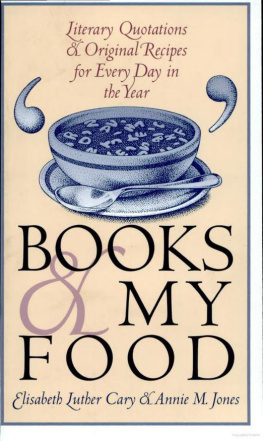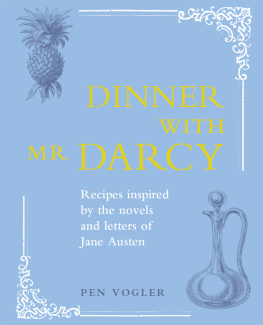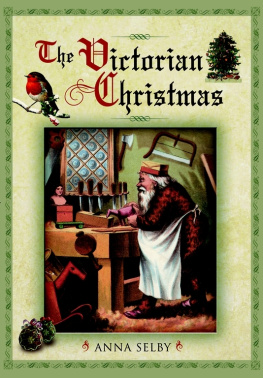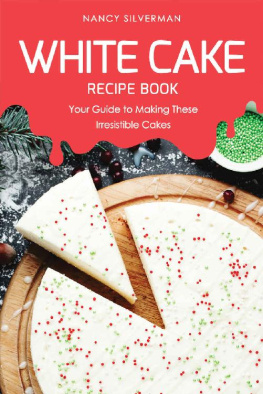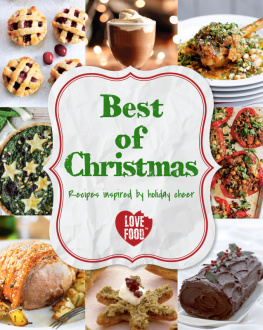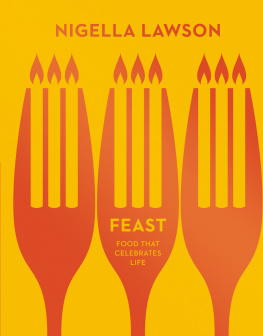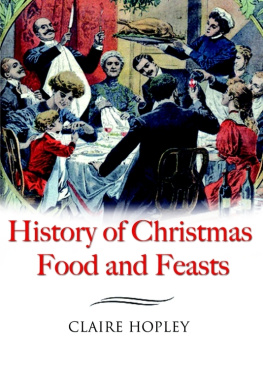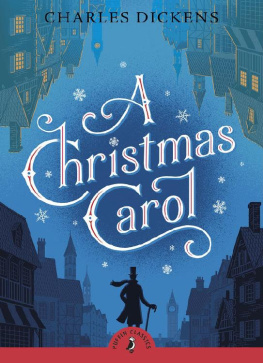| In her preface to Books and My Food (1904), the American literary and art critic Elisabeth Luther Cary declares that it is "impossible to read English novels without realizing how important a part food plays in the mental as in the physical life of the Englishman." This literary/culinary daybook, reissued for the first time in facsimile, provides a food-related quotation accompanied by a recipe for the foods mentioned, one pair for every day of the year. The authors quoted are almost entirely British and mostly well known, although W. A. Crofful and Jean Ingelow may not be household names now. The group is predominantly male, with a sprinkling of women present. Only Nathaniel Hawthorne and Henry James represent the Americans. |
| Little is known about Cary's coauthor Annie M. Jones, other than that she had published Friends for the Friendly: Quotations on Friendship and Homespun Candies: Simple and Thoroughly Tested Recipes for Candy known art critics in this country. For nearly thirty years her articles on many aspects of art, past and present, had appeared in The New York Times, revealing the point of view of a commentator exceptionally qualifed in her field, calmly unbiased amid controversy, and always alert to significant developments." |
| Food and the Arts: Past, Present, and Future |
A small sampling of culinary scholarship would range from The Loaded Table: Representations of Food in Roman Literature, Percorsi nelle Evidenze: Valenze Alimentari in "Pantagruel"and Tarte la Crme: Comedy and Gastronomy in Molire's Theaterto Jane Austen and Foodand What Jane Austen Ate and Charles Dickens Knew Culinary mysteries are either flourishing or bubbling over, according to different tastes: Someone Is Killing the Great Chefs of Europe, The Nantucket Diet Murders, A Tasty Way to Die, Murder on the Menu, Dying for Chocolate, The Body in the Cast, Too Many Crooks Spoil the Broth, The Mid-Atlantic Mystery Cookbook, and Murder Most Delicious. The subject of books and food reached some level of national awareness when it became the topic of a closing full-page feature in the New York Times Book Review. There, Walter Kendrick, a professor of English at Fordham University and the author of The Secret Museum: Pornograpby in Modern Culture, let off his own steam on the issue in ''Shut Up and Eat!"
In recent years a number of coffee-table books highlighting food and the painterly arts have included Art What Thou Eat: Images of Food in American Art, Toulouse-Lautrec's Table, The Impressionists' Table, and The Sun & Moon Guide to Eating through Literature and Art Since the famous eating scene in Tom Jones (the movie, 1963) aroused everyone's appetite(s), what might be labeled food films include Babette's Feast, Eat Drink Man Woman, Like Water for Chocolate, My Dinner with Andre, Tampopo, Home for the Holidays, The Big Chill, Fried Green Tomatoes, Il Postino, Apollo 13, Leaving Las Vegas, and The Bridges of Madison County In November 1996, a session of the Midwest Modern Language Association's annual program was devoted to "'Art What Thou Eat': Food in Literature, Art, and Culture," with four presenters, two from Romance language backgrounds and two from American literature backgrounds. The topics were "Feeding Fantasies: The Theatrics of Dining in the Spanish Theater of the Golden Age"; "You Are (Were) What You Eat: Food and Family in Ampara Davila's 'Alta Cocina'''; "'That Ever I Should Be Satisfied with Bread Again': Food as Pedagogy in Early American Women's Personal Narratives"; and "How to Eat, Drink, and Sleep as a Christian Should: Food, Gender, and Class in 19th-Century Domestic Serial Fiction."
When the Oxford Symposium on Food and Cookery convenes at St. Antony's College, Oxford (England) in 1998, the theme, chosen by a vote of some two hundred participating attendees in 1996, will be "Food and the Arts." If Cary and Jones's Books and My Food was decades ahead of its time, it has a lively successor in Peg Bracken's 1976 The I Hate to Cook Almanack: A Book of Days; Recipes & Relief for the Reluctant Cook and the Harried Houseperson. Bracken seasons her almanac with a batch of real authors, ranging from Cleveland Amory to Dereck Williamson, and asserts that "all the people quoted in this book are real, though some are real only to me."
In Books and My Food, the compilers, authors, and recipes are real and ready to be enjoyed again by a new generation of readers with educated palates!Interrelationships among food and the artsliterary, cinematic, painterly, musicalhave existed for centuries but are more noticeable today than ever before. The University of Iowa Libraries and its Szathmry Collection of Culinary Arts give a fair indication of the prevalence and range of topics on food and the arts. The Library of Congress has subject headings ranging from "Diners and Dining in Literature," "Gastronomy in Literature," "Cookery in Literature," and "Disorderly Eaters" to "Eating Disorders.''
J. K. Hoyt's The Romance of the Table (In Three Parts: I. Breakfast II. Dinner III. Tea) (1872) certainly takes the form of culinary fiction, but the importance of food in books goes as far back as Homer. The Thrill of the Grill has no description tastier than this scene in Iliad, Book I: "The offerings destined to do honour to the god were quickly set in place round the well-built altar.... They ... wrapped them in folds of fat and laid raw meat above them.... Young men gathered round ... with five-pronged forks in their hands. When the thighs were burnt up and they had tasted the inner parts, they carved the rest into small pieces, pierced them with skewers, roasted them thoroughly, and drew them all off. Their work done and the meal prepared, they fell to with a good will on the feast, in which all had equal shares."
In Odyssey, Book VII, Odysseus speaks as a guest of Alcinous: "I would ask you now to let me eat. There is nothing more devoid of shame than the accursed belly; it thrusts itself upon a man's mind in spite of his afflictions, in spite of his inward grief. That is true of me; my heart is sad, but my belly keeps urging me to have food and drink, tries to blot out all the past from me; it says imperiously: 'Eat and be filled.'" Later, Odysseus, "having just cut a portion, rich in fat, from the chine of a white-tusked boar, sends it to the bard Demodocus, 'Let Demodocus have this dish to eat; I must do him this courtesy.'"
|
|

